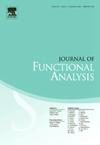Stability threshold of Couette flow for the 3D MHD equations
IF 1.7
2区 数学
Q1 MATHEMATICS
引用次数: 0
Abstract
In this paper, we consider the stability of 3D Couette flow in a uniform background magnetic field . In particular, the MHD equations on that we are concerned with are of different viscosity coefficient ν and magnetic diffusion coefficient μ. It is shown that if the background magnetic field with satisfying a generic Diophantine condition is so strong that , and the initial perturbations and satisfy for sufficiently large N, then the resulting solution remains close to the steady state in at the same order for all time. Compared with the result of Liss [Comm. Math. Phys., 377(2020), 859–908], we use a more general energy method to address the physically relevant case based on some new observations.
求助全文
约1分钟内获得全文
求助全文
来源期刊
CiteScore
3.20
自引率
5.90%
发文量
271
审稿时长
7.5 months
期刊介绍:
The Journal of Functional Analysis presents original research papers in all scientific disciplines in which modern functional analysis plays a basic role. Articles by scientists in a variety of interdisciplinary areas are published.
Research Areas Include:
• Significant applications of functional analysis, including those to other areas of mathematics
• New developments in functional analysis
• Contributions to important problems in and challenges to functional analysis

 求助内容:
求助内容: 应助结果提醒方式:
应助结果提醒方式:


